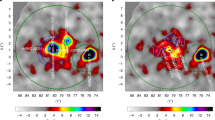Abstract
Like many other X-ray sources, Cygnus X-3 seems to be a binary system that includes a compact object, but it is unusual in being enshrouded in gas, in displaying occasional huge outbursts and in emitting much more energy above 1011 eV than in the keV X-ray region. If the compact object is a pulsar, the ultra-high-energy photons can be products of an accelerated beam of protons (or nuclei) striking the companion's atmosphere1,2. It is noted here that a roughly monoenergetic spray of ∼1017 eV protons at ∼1039 erg s−1, generating an electron–photon cascade in the environs of the companion star, best accounts for all photons above a few GeV, and might generate the gas shroud, as beam energy deposition inside the star could lift off a thick layer of matter to generate a fountain under the pulsar. This evidence on the nature of the accelerated beam is particularly significant as Cygnus X-3 seems likely to be responsible for most of the cosmic ray particles around 1017 eV which are at present being injected into the Galaxy.
This is a preview of subscription content, access via your institution
Access options
Subscribe to this journal
Receive 51 print issues and online access
$199.00 per year
only $3.90 per issue
Buy this article
- Purchase on Springer Link
- Instant access to full article PDF
Prices may be subject to local taxes which are calculated during checkout
Similar content being viewed by others
References
Vestrand, W. T. & Eichler, D. Astrophys. J. 261, 251–258 (1982).
Eichler, D. & Vestrand, W. T. Nature 307, 613–614 (1984).
Samorski, M. & Stamm, W. Astrophys. J. Lett. 268, L17–L21 (1983).
Lloyd-Evans, J. et al. Nature 305, 784–787 (1983).
Stephens, S. A. & Verma, R. P. Nature 308, 828–830 (1984).
Vestrand, W. T. Astrophys. J. 271, 304–314 (1983).
Ghosh, P., Elsner, R. F., Weisskopf, M. C. & Sutherland, P. G. Astrophys. J. 251, 230–245 (1981).
Wdowczyk, J. & Wolfendale, A. W. Nature 306, 347–349 (1983).
Wdowczyk, J. & Wolfendale, A. W. Nature 305, 609–610 (1983).
Berezinsky, V. S., Mikhailov, A. A. & Syrovatskii, S. I. Proc. 16th int. Conf. Cosmic Rays, Kyoto, Vol. 2, 86–91 (University of Tokyo, 1979).
Kiraly, P., Kota, J., Osborne, J. L., Stapley, N. R. & Wolfendale, A. W. Riv. nuovo Cim. (Ser. 3) 2, No. 7 (1979).
Hillas, A. M. A. Rev. Astr. Astrophys. 22, 425–444 (1984).
Koch-Miramond, L. 19th Rencontre de Moriond: 4th Moriond Astrophys. Meet. (Frontiéres, Dreux, in the press).
Protheroe, R. J., Clay, R. W. & Gerhardy, P. R. Astrophys. J. 280, L47–L50 (1984).
Gunn, J. E. & Ostriker, J. P. Phys. Rev. Lett. 22, 728–731 (1969).
Bignami, G. F., Marschi, L. & Treves, A. Astr. Astrophys. 55, 155–158 (1977).
Dowthwaite, J. C. et al. Astr. Astrophys. 126, 1–6 (1983).
Neshpor, Yu. I. et al. Astrophys. Space Sci. 61, 349–355 (1979).
Lamb, R. C., Godfrey, C. P., Wheaton, W. A. & Tumer, T. Nature 296, 543–544 (1982).
Stepanian, A. A., Fomin, V. P., Neshpor, Yu. I., Vladimirsky, B. M. & Zyskin, Yu. L. Proc. Int. Workshop on Very High Energy Gamma-Ray Astronomy, Ootacamund (eds Ramana Murthy, P. V. & Weekes, T. C.) 43–63 (Tata Institute of Fundamental Research and Smithsonian Institution, Bombay, 1982).
Danaher, S., Fegan, D. J., Porter, N. A. & Weekes, T. C. Nature 289, 568–569 (1981).
Mukanov, J. B., Nesterova, N. M., Stepanian, A. A. & Fomin, V. P. Proc. 16th int. Conf. Cosmic Rays, Kyoto, Vol. 1, 143–146 (University of Tokyo, 1979).
Morello, C., Navarra, G. & Vernetto, S. Proc. 18th int. Conf. Cosmic Rays, Bangalore, Vol. 1, 127–130 (Tata Institute of Fundamental Research, Bombay, 1983).
Author information
Authors and Affiliations
Rights and permissions
About this article
Cite this article
Hillas, A. Is Cygnus X-3 a monoenergetic 1017 eV accelerator?. Nature 312, 50–51 (1984). https://doi.org/10.1038/312050a0
Received:
Accepted:
Issue Date:
DOI: https://doi.org/10.1038/312050a0
This article is cited by
Gamma-ray astronomy by the air shower technique: Performance and perspectives
Il Nuovo Cimento C (1996)
TeV emission from close binaries
Space Science Reviews (1995)
Particle acceleration and main parameters of ultra-high energy gamma-ray binaries
Astrophysics and Space Science (1991)
The plasma physics of shock acceleration
Space Science Reviews (1991)
Primary cosmic gamma rays of ultrahigh energies
Astrophysics (1990)
Comments
By submitting a comment you agree to abide by our Terms and Community Guidelines. If you find something abusive or that does not comply with our terms or guidelines please flag it as inappropriate.



